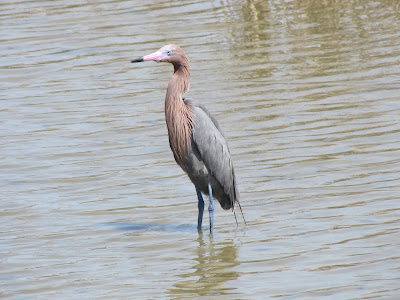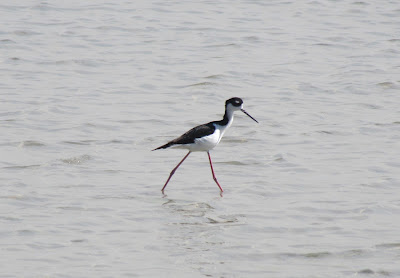We've back from our winter escape from Texas, so it's time for a summary. The first thing that comes to mind is that is was cold. Before 2021, winters in Corpus Christi would follow a pattern of 3-4 warm days, with sun and temperatures in the 60s or 70s, followed by 3-4 cold days, where temperatures dropped to around 50 F (10 C). Quite often, we'd also get decent sessions on the colder days, since the water would remain comfortably warm for the first couple of cold days.
This year was different: the cold spells lasted longer, often 5 to 7 days, and the warm spells seemed shorted. On January 20, the air temperatures dropped below 40 F, and it took until February 2 before it got up to 70 again ... only to drop down to below freezing two days later, and then remain below 70 for another couple of weeks. Interestingly, the colder weather is likely to be a consequence of global warming, which weakens the jet stream and thus causes more "blocking", where weather remains "stuck" for longer times. I find it scary that this seems to have become an easily observable trend already .. and that it's effect of making winters in Texas colder may prevent locals from realizing that climate change is real, and carbon emissions really must be reduced.
After having experienced 6 freezing cold days without power in Texas last year, we escaped the cold period in February by driving to Florida. That was an astonishingly long drive (1,260 miles), but well worth it. We visited our friend Joanie, foiled and winged at a few new spots, and I even got to take a one-day wing clinic with Andy Brandt, which was great. I got a few longer rides and can now at least imagine that winging could be fun.
In March, it finally got (mostly) warm, and we had a lot of days with wind in the 20-30 mph range, and temperatures in the high 60s and low 70s. After getting onto the water only about every third day in January and February, I got 21 sessions in March. 11 of those were speed sessions on slalom gear, mostly at Grassy Point and with Nina. I ended up getting above 35 knots a couple of times, which I had previously not done in the USA, and set a new personal best for the nautical mile (32.12 knots) on the last day. But my speed improvements paled against Nina's.
In the last couple of years, Nina had been stuck at a top speed just below 32 knots in Corpus Christi. But after a few successive speed sessions in March, something clicked, and she got a 2-second top speed above 34 knots on March 18. She also set a new PB for the nautical mile (30.448 knots) the same day. After this session, she had no problem getting above 33 knots, proving that she had indeed learned to go faster.
Towards the end of our trip, we got lucky: 3 windy days in a row, with low tide levels which meant flat water at Grassy Point. On our last day of sailing, Nina set a new top speed PB with 36.103 knots, easily beating my speed for the day. She also improve her nautical mile PB again, to 30.962 knots. For her top speed, she had found a spot of very flat water right next to the shipping channel near Padre Island. She later showed me the spot, but by then, the wind had dropped.
Since we had so many cold days in the first two months of our trip this year, we ended up with a new hobby: bird watching. Corpus Christi may be one of the best spots to get started with taking bird pictures, since it has lots and lots of impressive water birds that are not shy at all. We ended up with photos from more than 40 different bird species, and a few other animals like coyotes, deer, and crocodiles. Here are a few of my favorites:
 |
| Willet - a common sight |
 |
| Royal Terns. Love the hairdo. |
 |
| Roseate Spoonbills and Little Blue Heron |
 |
| Reddish Egret |
 |
| Long-billed Curlew. A few often hang out near the Bird island windsurf launch. |
 |
| White Pelican |
 |
| Windsurfer and a flock of Ibis |
 |
| Great Blue Heron and Great Egret, two very common sights. |
 |
| Black-necked Stilt. Elegance defined. |








